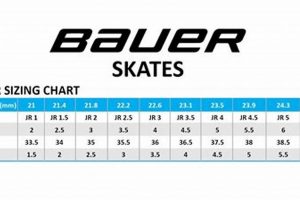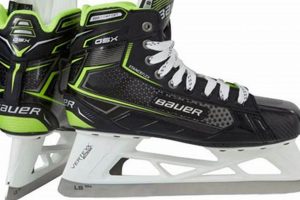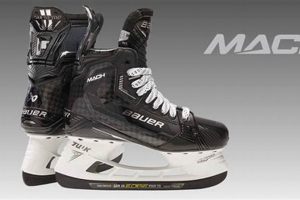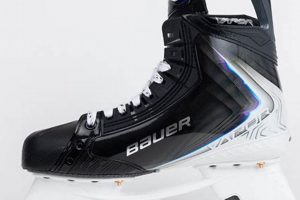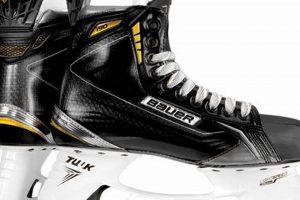A table outlining dimensions for appropriate fit, categorized by foot size, is an essential resource when selecting ice skates for young individuals manufactured by Bauer. This chart commonly presents foot measurements in inches or centimeters, correlated with suggested skate sizes, allowing purchasers to choose equipment that provides both comfort and safety.
Utilizing precise sizing information is crucial for optimal performance and injury prevention in youth hockey and recreational skating. Properly fitted skates enhance agility, control, and overall enjoyment, while ill-fitting equipment can lead to discomfort, blisters, or even more serious foot and ankle problems. Historically, accurately determining skate size relied heavily on in-person fitting at specialty retailers; the availability of standardized charts improves the selection process for online or remote purchasing.
The following sections will delve into factors influencing skate sizing, discuss common variations in sizing methodologies, and provide guidance on utilizing measuring tools for the purpose of accurate selection.
Guidance on Utilizing Youth Hockey Skate Sizing Charts
The following recommendations aim to provide clarity when employing manufacturer-provided skate sizing guides to ensure proper fit and optimal performance for young skaters.
Tip 1: Accurate Foot Measurement: Employ a Brannock device or a ruler to measure the skater’s foot length and width accurately. Measurements should be taken while the individual is standing with weight evenly distributed. Repeat the process for both feet, as slight variations in size are common.
Tip 2: Consult the Specific Chart: Reference the specific chart pertaining to the Bauer model being considered. Sizing can vary even within the same brand across different product lines or model years. Verify the chart’s publication date to ensure it reflects the current skate design.
Tip 3: Prioritize Length: Length is the primary factor in determining skate size. Choose the size that corresponds most closely to the longer foot measurement. Minor adjustments in width can sometimes be accommodated through lacing techniques or professional skate modification, but length is less adaptable.
Tip 4: Account for Sock Thickness: When measuring, ensure the skater is wearing the type of sock typically used for skating. Thicker socks can impact the required skate size. Avoid excessively thick socks, as they can hinder performance and reduce feel.
Tip 5: Consider Growth Potential: While a snug fit is optimal, allow for a small amount of growth, particularly for rapidly developing youngsters. However, avoid selecting a skate that is excessively large, as it will compromise control and potentially increase the risk of injury.
Tip 6: Professional Fitting: Whenever feasible, seek professional fitting assistance from a knowledgeable skate retailer. A trained fitter can assess foot shape, identify potential pressure points, and provide personalized recommendations.
Tip 7: Assess Fit In-Skate: After receiving the skates, the skater should wear them for a short period indoors to assess the fit. Properly tightened laces should provide a secure and comfortable fit, with the heel locked firmly in place. Minimal forward movement of the foot within the boot is desirable.
Adhering to these guidelines should improve the likelihood of selecting appropriately sized skates, contributing to enhanced performance, comfort, and safety on the ice.
The subsequent sections will address frequently asked questions and offer supplementary resources for further assistance.
1. Foot Length Accuracy
Foot length accuracy constitutes a foundational element in the effective application of a Bauer youth skate size chart. The chart relies on correlating foot dimensions with corresponding skate sizes. Imprecise foot measurements introduce errors that cascade through the selection process, potentially resulting in a poor skate fit. For instance, if a youth’s foot measures 7.5 inches, the corresponding skate size, as indicated on the relevant chart, might be a Y12. However, if an inaccurate measurement of 7 inches is recorded, the selected skate size (e.g., Y11) would be demonstrably too small, impacting comfort and performance.
The consequences of inaccurate foot length measurements extend beyond mere discomfort. Improperly fitted skates can lead to blisters, pressure sores, and even more serious orthopedic issues. In the context of hockey, poorly fitting skates compromise agility and control, increasing the risk of falls and injuries. Furthermore, the biomechanics of skating rely on a secure and stable interface between the foot and the skate. Inaccurate sizing disrupts this interface, hindering power transfer and reducing skating efficiency. Consistent and precise foot measurements, preferably conducted using a calibrated Brannock device or similar tool, are therefore indispensable for realizing the intended benefits of a skate size chart.
In summary, the value of a Bauer youth skate size chart is contingent upon the precision of the input data, namely, accurate foot length measurements. While the chart provides a standardized guide, it serves only as a starting point. Prioritizing accurate measurement practices mitigates the risk of selecting ill-fitting skates, ultimately safeguarding the skater’s comfort, performance, and long-term foot health. This necessitates employing proper measuring tools and techniques to avoid common errors and ensure a reliable assessment of foot size prior to consulting any skate sizing chart.
2. Width Considerations
Width considerations are integral to the proper application of any youth hockey skate sizing guide, particularly those provided by Bauer. Length alone does not fully define skate fit; foot width significantly influences comfort, performance, and potential for injury. Neglecting width when consulting a sizing chart can lead to suboptimal skate selection, even if the length is accurately determined.
- Foot Shape Variance
Human feet exhibit substantial variations in width, ranging from narrow to wide. Standard sizing charts often assume an average foot width, which may not accurately represent the foot of every young skater. A skater with a wide foot, when forced into a standard-width skate corresponding to their length, will experience discomfort, pressure points, and potential circulation restriction. Conversely, a skater with a narrow foot in a standard-width skate may experience excessive movement within the boot, compromising stability and control. The implications for performance are significant, as a properly supported foot facilitates efficient power transfer and precise movements.
- Bauer Skate Width Options
Recognizing the importance of width, Bauer typically offers select skate models in multiple width options, designated by codes such as “D” (standard), “EE” (wide), or sometimes others. The youth skate size chart should, therefore, be used in conjunction with an assessment of foot width. If a skater’s foot is noticeably wider than average, selecting a “EE” width skate, even if it means adjusting the length slightly, may be preferable to forcing the foot into a standard “D” width. Professional fitting, which includes width assessment, is crucial in such cases.
- Impact on Performance and Injury
Inadequate width accommodation can negatively impact both performance and increase injury risk. Skates that are too narrow can cause blisters, bunions, and nerve compression. Furthermore, the discomfort can distract the skater, reducing focus and potentially leading to errors. Skates that are too wide compromise ankle support and stability, increasing the risk of ankle sprains. Youth skaters, whose feet are still developing, are particularly vulnerable to the negative effects of poorly fitting skates. Therefore, attending to width during skate selection is not merely a matter of comfort but also a crucial safety consideration.
In conclusion, width considerations cannot be overlooked when utilizing a youth skate sizing guide. Ignoring width can lead to discomfort, impaired performance, and increased risk of injury. By considering foot shape variance, utilizing Bauer’s width options, and understanding the performance and injury implications of improper width accommodation, one can more effectively apply the chart to select skates that provide a secure, comfortable, and supportive fit for young skaters.
3. Model Specificity
Model specificity holds significant relevance in conjunction with youth skate sizing information. Each skate model, even within a single manufacturers product line, may exhibit unique internal dimensions and construction characteristics that influence fit. Therefore, reliance solely on a generic sizing chart, without accounting for the specific model, introduces a significant source of error. For example, a Bauer Vapor skate in size Y13 may fit differently than a Bauer Supreme skate of the same nominal size due to variations in boot shape, internal padding, and overall design. This disparity necessitates consulting the model-specific size chart for each individual skate being considered.
The cause of these dimensional differences arises from variations in the manufacturing processes and design philosophies associated with each model. One model may prioritize a narrower, more anatomical fit for enhanced agility, while another emphasizes a more voluminous fit for increased comfort and stability. Neglecting model specificity can lead to the selection of skates that are either too tight, restricting circulation and causing discomfort, or too loose, compromising ankle support and control. The importance of model-specific charts is further underscored by the frequent updates and revisions made to skate designs. A sizing chart from a previous model year may not accurately reflect the fit characteristics of the current iteration.
In conclusion, model specificity constitutes a critical factor in the accurate utilization of youth skate size charts. Generic charts offer a general guideline, but model-specific charts must be consulted to ensure a proper fit that optimizes comfort, performance, and safety. Failing to account for model-specific variations in sizing undermines the effectiveness of any skate fitting process, potentially leading to suboptimal or even detrimental outcomes for the young skater. Regular reference to current, model-specific sizing resources is an essential step in the skate selection process.
4. Growth Allowance
Growth allowance, in the context of selecting youth hockey skates, represents the deliberate addition of extra space within the skate boot to accommodate the natural growth of a child’s foot. This allowance is factored into the application of a Bauer youth skate size chart, introducing a calculated deviation from the chart’s indicated size based on current foot measurements. The practice necessitates careful consideration to balance longevity of use with immediate performance and safety.
- Balancing Longevity and Performance
An appropriate growth allowance aims to extend the usable lifespan of the skates, thereby mitigating the financial burden associated with frequent replacements. However, excessive allowance compromises the skater’s control and stability, increasing the risk of falls and injuries. A widely oversized skate does not provide the necessary support for proper ankle flexion and power transfer, hindering skill development. The ideal growth allowance represents a compromise, permitting a modest amount of foot growth without sacrificing immediate performance capabilities.
- Impact on Skate Fit and Comfort
The decision to incorporate a growth allowance directly influences the fit and comfort of the skate. A properly fitted skate, based strictly on the size chart, provides a snug and secure feel, maximizing responsiveness and minimizing friction. Introducing a growth allowance inevitably loosens the fit, potentially creating areas of slippage and increasing the likelihood of blisters. Mitigation strategies, such as thicker socks or insole adjustments, may partially compensate for the extra space, but cannot fully replicate the precision of a skate sized exactly to the current foot dimensions.
- Variations in Growth Patterns
Youth growth patterns are not uniform; some children experience rapid growth spurts, while others grow at a more gradual pace. The optimal growth allowance should, ideally, reflect the individual skater’s expected growth rate. Accurately predicting future growth is inherently challenging, making the selection of an appropriate allowance a matter of informed estimation rather than precise calculation. Parental observation and consultation with skate fitting professionals can aid in refining this estimate.
- Professional Recommendations vs. Parental Preferences
Skate fitting professionals typically advocate for a minimal growth allowance, prioritizing immediate performance and safety over extended usage. Parental preferences, often driven by budgetary concerns, may lean towards a larger allowance. A constructive dialogue between parents and professionals is essential to reconcile these competing priorities and arrive at a decision that serves the best interests of the young skater. Ultimately, the choice of growth allowance represents a calculated trade-off between short-term performance and long-term cost-effectiveness.
In summary, growth allowance modifies the direct application of a Bauer youth skate size chart. While the chart provides a baseline for proper sizing, growth allowance represents a deliberate deviation based on anticipated foot growth, aiming to balance cost-effectiveness with immediate performance and safety. Recognizing the trade-offs and factors involved facilitates a more informed and responsible skate selection process.
5. Sock Thickness
Sock thickness presents a crucial variable when utilizing sizing guidelines. Footwear dimensions are standardized under the assumption of a baseline sock profile. Deviations from this assumed profile, through the employment of thicker or multiple socks, directly impact the accuracy of size chart recommendations.
- Impact on Internal Volume
Increased sock thickness reduces the internal volume within the skate boot. A youth’s foot, measured and sized appropriately with a thin sock, may encounter a constricted fit when a thicker sock is introduced. This constriction can manifest as discomfort, reduced circulation, and potential pressure points along the foot’s surface. The indicated size on a Bauer youth skate size chart is predicated on a minimal sock thickness; any significant increase necessitates a reassessment of the appropriate skate size. Example: If a youth is measured to need a Y12 skate, using a thin hockey sock, then thicker sock can shift requirement to a Y12.5 or Y13
- Effect on Fit and Performance
Altering sock thickness affects the overall fit and, consequently, skating performance. A loose-fitting skate, resulting from overly thin socks, compromises ankle support and stability, hindering power transfer and control. Conversely, an overly tight skate, caused by excessive sock thickness, restricts foot movement and can lead to numbness or blisters. The design of ice skates presumes a close, responsive fit; modifications to sock thickness can disrupt this engineered interface. Example: Youth level players or new players should use sock thickness that enable comfort fit; but that should never hinder skating level.
- Material Considerations
Different sock materials possess varying degrees of thickness and compression. Wool or synthetic blends tend to be thicker and offer greater insulation compared to thinner, moisture-wicking materials. The choice of sock material thus influences the overall fit and feel of the skate. Selecting a sock specifically designed for ice skating, typically featuring a thin profile and moisture-wicking properties, is recommended to minimize the impact on sizing accuracy. Example: High quality cotton socks are more expensive than synthetic blend ones.
- Compensatory Adjustments
When a youth skater prefers thicker socks, compensatory adjustments to the skate size are necessary. The precise adjustment depends on the magnitude of the sock thickness increase. Consulting a skate fitting professional is advisable, as they can accurately assess the impact of sock thickness and recommend the appropriate size alteration. Alternatively, loosening the skate laces may provide some relief, but this approach compromises support and is not a substitute for proper sizing. Example: Thicker socks should only be used if player’s foot is growing and parent does not want to purchase new pair of bauer youth skate.
The interaction between sock thickness and sizing charts underscores the importance of comprehensive fitting practices. While size charts offer a standardized guide, individual preferences and circumstances, such as sock choice, require careful consideration. A holistic approach, encompassing accurate foot measurements, appropriate sock selection, and professional consultation, maximizes the likelihood of achieving an optimal and comfortable skate fit.
6. Professional Fitting
Professional fitting, as a service provided by trained skate specialists, enhances the utility of a Bauer youth skate size chart. While the chart provides a standardized guide, it cannot account for individual foot characteristics and skating preferences. A professional fitting session integrates the size chart with hands-on assessment, yielding a more precise and personalized outcome.
- Accurate Foot Measurement and Assessment
Professional fitters possess the tools and expertise to conduct precise foot measurements, including length, width, and arch height. They can identify foot irregularities, such as bunions or pronation, which impact skate fit. They can then match that data to the skate size chart. Example: A fitter might note a youth skater has wide feet or pronation of the ankle, and select size chart or recommend orthotic. A fitter ensures accuracy beyond self-measurements, mitigating errors resulting from incorrect technique or equipment.
- Model-Specific Knowledge and Recommendations
Fitters maintain in-depth knowledge of various Bauer skate models and their unique fit characteristics. They can advise on which models are best suited for a skater’s foot shape, skating style, and skill level. This expertise complements the size chart by providing context and nuance, ensuring the selected skate is not only the correct size but also the optimal choice for the individual. Example: A new skater versus competitive player should choose model that reflects their skill level and style of play.
- Heat Molding and Customization
Many Bauer skates are heat moldable, allowing the fitter to customize the boot’s shape to the skater’s foot. This process further enhances the fit, eliminating pressure points and improving comfort. Professional fitters possess the equipment and skills necessary to perform heat molding safely and effectively, maximizing the benefits of this technology. Heat molding optimizes the fit around the ankle and heel, improving support and stability. Heat molding optimizes the fit around the ankle and heel, improving support and stability.
- Addressing Fit Issues and Providing Solutions
Even with the correct size and heat molding, minor fit issues may arise. Professional fitters can identify and address these issues using various techniques, such as punch-outs, foam padding, or insole adjustments. Their expertise ensures that the skate fits comfortably and performs optimally, minimizing the risk of blisters, discomfort, or injury. Example: A pressure point that is causing pain is addressed using punch-outs on the outside of the skate to enable comfort.
In summary, professional fitting serves as a critical adjunct to a Bauer youth skate size chart. It combines precise measurement, model-specific knowledge, customization techniques, and problem-solving skills to deliver a superior skate fit that optimizes performance, comfort, and safety. While the size chart provides a valuable starting point, professional fitting ensures the final result is tailored to the individual skater’s unique needs and preferences.
Frequently Asked Questions Regarding Bauer Youth Skate Sizing
The following section addresses commonly asked questions pertaining to Bauer youth skate dimensions, aiming to clarify uncertainties and facilitate informed purchase decisions.
Question 1: Does the size of a child’s street shoe directly correlate to the appropriate size in Bauer youth ice skates?
No, street shoe size does not reliably translate to ice skate size. Skate sizing systems differ significantly from shoe sizing. Consulting a size chart specific to the particular Bauer skate model is essential.
Question 2: Are Bauer youth skate sizing charts standardized across all models?
No, dimension charts can differ among various models and product lines. Checking the chart specific to the skate being considered is vital to confirm proper sizing.
Question 3: How should foot width be accommodated when using a Bauer youth skate size chart?
Foot width should be measured and compared to width guides, if provided, on the selected skate model’s size chart. Skates are often available in different widths (e.g., D, EE) to accommodate varying foot shapes.
Question 4: What amount of space should be left in the toe of a youth skate for growth?
A minimal amount of space, approximately a thumb’s width (around 1 cm), is generally recommended to allow for growth without compromising performance. Excessive space diminishes control and can increase injury risk.
Question 5: Can thicker socks compensate for skates that are slightly too large?
Thicker socks are not a substitute for properly fitted skates. While they may temporarily improve fit, they can reduce sensitivity and impede performance. Using correctly sized skates with appropriate hockey socks is preferable.
Question 6: Is professional skate fitting necessary when purchasing Bauer youth skates?
Professional fitting is highly recommended, particularly for first-time skate purchasers or those unfamiliar with skate fitting procedures. A professional can accurately assess foot dimensions, consider individual skating needs, and ensure a proper fit.
In summary, selecting correctly sized skates requires careful attention to measurement, model specificity, and individual foot characteristics. Relying solely on general guidelines or street shoe sizes is discouraged. Consulting size charts and seeking professional assistance is essential for optimal results.
The subsequent section provides additional resources for locating Bauer youth skate sizing charts and identifying authorized retailers.
Accurate Selection Through Sizing Charts
This exploration has underscored the importance of the skate dimension table for the appropriate fitting of youth sporting equipment. Precise foot measurement, combined with consultation of model-specific charts, and consideration of individual factors, like width and growth allowance, are vital for optimal skate selection. Professional fitting services further enhance the probability of an accurate and comfortable outcome.
Proper skate fit directly influences a young skater’s performance, comfort, and safety. Skaters are encouraged to diligently consult resources and seek expert assistance to ensure optimal fit. A commitment to precise sizing procedures contributes significantly to the overall skating experience, as selecting the right sizes allows young player develop skills properly.


